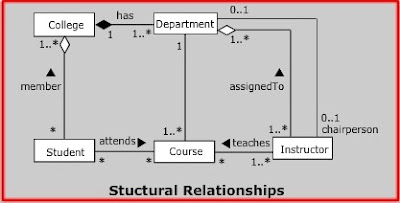Relationships
Common Modeling Techniques
Modeling Single Inheritance:
To model inheritance relationships:
- Identify the responsibilities, attributes and operations, which are common to two or Security more classes, in a given set of classes
- Now, the common responsibilities, attributes and operations must be moved up to a more general class
- In order to assign the common elements, create a new class and remember not to introduce too many levels
- Mention that the more-specific classes are derived from the more-general class. This is possible by placing a generalization relationship drawn from each specialized class to its parent which is more general

Modeling Structural Relationships
To model structural relationships:
- In each pair of classes, if the objects of one class need to navigate to objects of another, depict an association between the two
- This is a view of associations driven by data
- For each pair of classes, specify an association between the two classes, if objects of one class are required to interact with objects of other class, except as local variables or parameters of an operation
- It is more of behavioral association
- Indicate a multiplicity for each of these associations (especially when the multiplicity is not the default *) as well as role names
- There may be a whole-part association (structurally or organizationally) between two classes. In such a case, mark it as an aggregation by enhancing the association at the end near the whole with a diamond

Relationships at Glance

Post a Comment
Post a Comment